When making a vegetable risotto, I favor grating some of the vegetable in question or otherwise reducing it to a near-puree and cooking it along with the rice. This adds a more luxurious consistency and infuses flavor right into the grain. Freshness and texture can then come from chunks or dice of the same vegetable added toward the end of cooking. I’ve taken this approach for mushroom risottos, but never to quite the extent that I did the other day, when I used a total of a pound and a quarter (570 g) of mushrooms for just enough risotto to feed Jackie and me plus a friend.
I began with a clump of hen-of-the-woods (maitake) weighing around 10 ounces (285 g). I cut the numerous caps from the stalk and set them aside, then chopped the stalk and simmered it in a quart (liter) of diluted chicken stock, along with a sprinkle of salt, a scrap of kombu for extra savoriness/umami and a few sage leaves to remind myself that an Italian-style dish was in the offing. When this had simmered for half an hour, I left it to steep until tepid, then strained it.
As it was cooling, it occurred to me that this prospective risotto – which would be subtly mushroomy – would benefit from the intensified flavor of mushroom mush cooked along with the rice. So I went to the supermarket on our corner and bought a 10-ounce (285 g) package of ordinary white mushrooms. I wiped them (fairly) clean and finely minced them in the food processor with a couple of leaves of sage; they were just about pureed. After melting a tablespoon of butter in a skillet, I added the pureed mushrooms and some salt and cooked them over medium heat, stirring frequently, until they had reduced to a thick, brown mass – in effect, an allium-free duxelles. Mushrooms being what they are (mostly water), even this dense, thickened, delicious puree remained very moist.
(Remember: Ordinary mushrooms are wonderful things – it’s nice to have the exotica, but I’d use the everyday variety for this entire dish. In a flash.)
To make the risotto I used the old-fashioned method of constant stirring. Nothing new here: I sweated a big shallot, minced, in olive oil; stirred in the rice (something less than a cup of the carnaroli variety – say 225 ml by volume – for the three of us) and cooked it in the oil for half a minute before adding a scant quarter cup (50 ml, say) white wine and reducing it. I then incorporated all of the mushroom puree and began the pleasant task of adding heated-up mushroom-scented stock a little at a time and stirring the risotto energetically. Et cetera: see any old-fashioned risotto recipe or take a look at the story I wrote after a risotto lesson in Venice.
While this was happening, I gave the maitake caps a sauté in minimal olive oil, using highish heat to slightly crisp their edges; they cooked quickly: compared with the stalk, the caps are very tender. You could do this before starting the rice if you’re uneasy about stirring and sautéing at the same time.
When the rice was done, I checked for seasoning (pepper was called for), added the sautéed maitake caps, covered the pan and left it alone for three minutes, at which point I vigorously stirred in a scant ounce (20 or 25 g) of butter and a small handful of a mixture of parsley and sage, chopped. Parsley alone would be fine, and, throughout the recipe, you could use a wee bit of thyme in place of the sage, but only a wee bit lest it take control of the entire dish. At this point I also beat in a little more stock to attain a properly fluid consistency – this may be unnecessary, but be ready for the possibility.
Between all those mushrooms and the kombu-tinged stock, the risotto was so savory that I added no grated parmesan. But I did bring some to the table; after experimental spoonsful, everyone agreed that cheese would be superfluous. But offering it would be neighborly, so you might as well give people the option.
When the Great Mushroom Varieties are available – porcini, chanterelles and a few others – we eat wonderful risottos at home and, occasionally, in restaurants. But they rarely beat this one, with its supermarket-mushroom base.
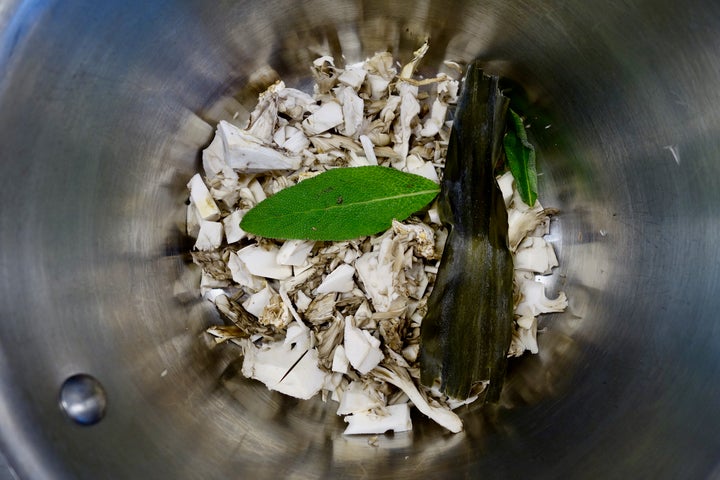
Stalk of hen-of-the-woods mushroom (maitake) with sage and kombu
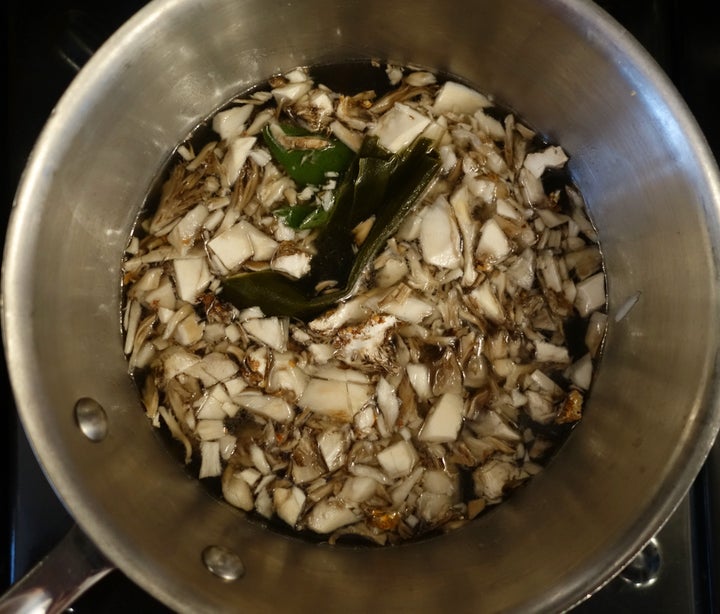
Simmered and steeped in chicken stock: a mushroomy broth for the risotto
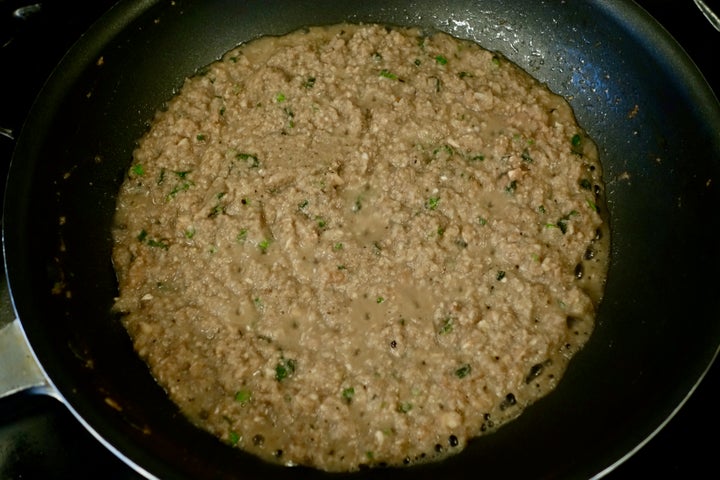
Ten ounces of supermarket mushrooms, food-processed with parsley and sage, and cooking down with butter
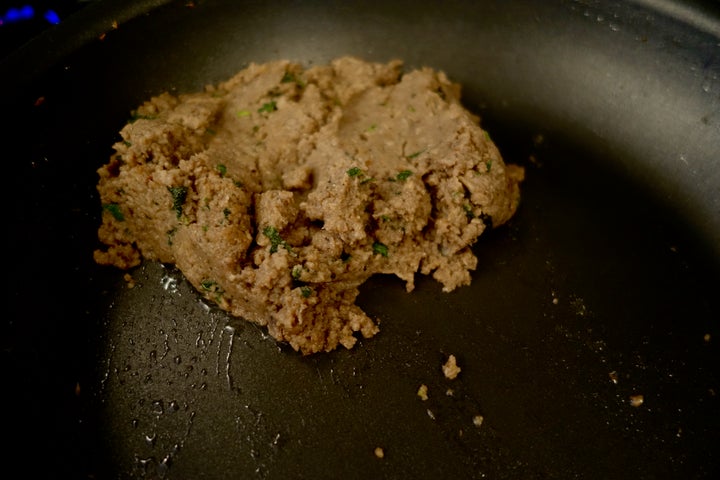
After twenty minutes or so, an intense mushroom puree
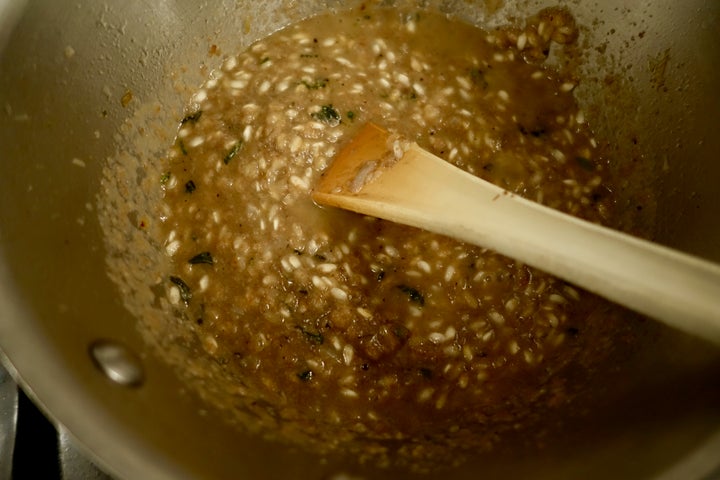
The puree goes into the risotto right after the rice and white wine
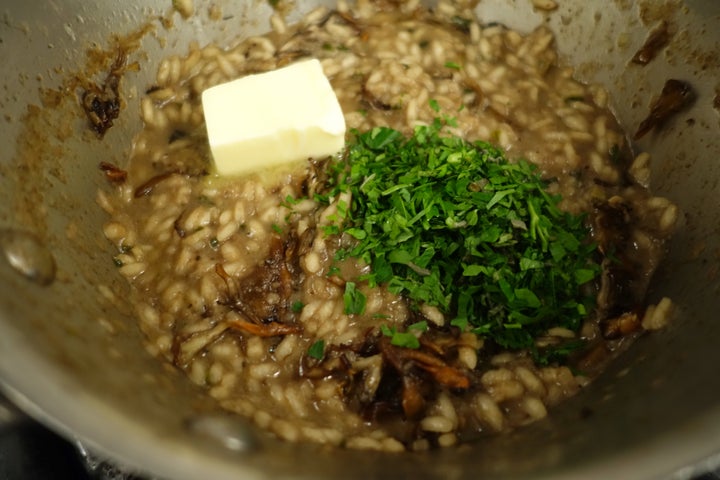
The finished risotto: sauteed maitake caps added, and butter and herbs about to be vigorously stirred in. We ate too avidly to permit a final plated photograph